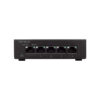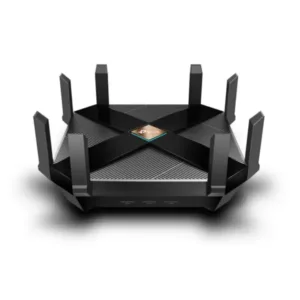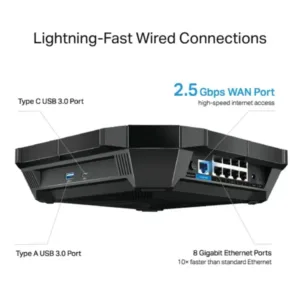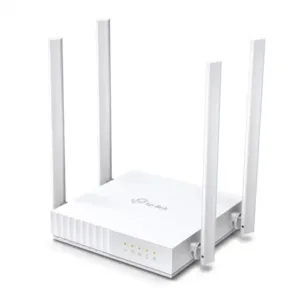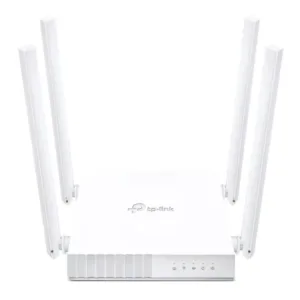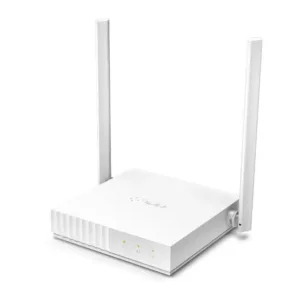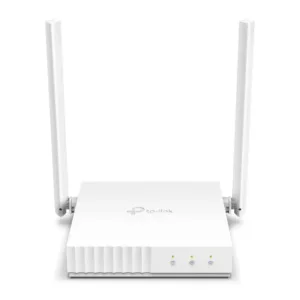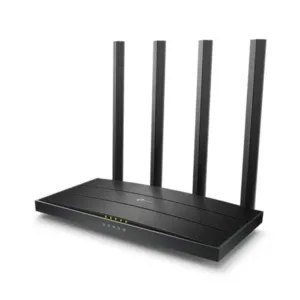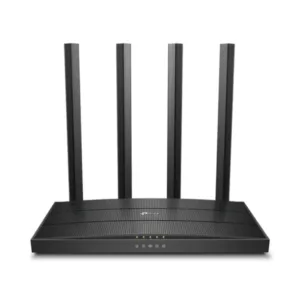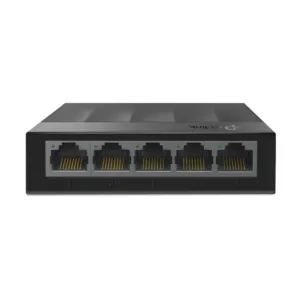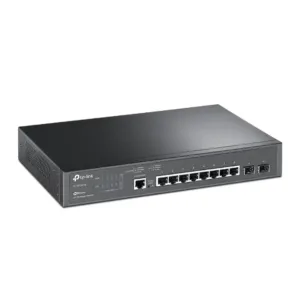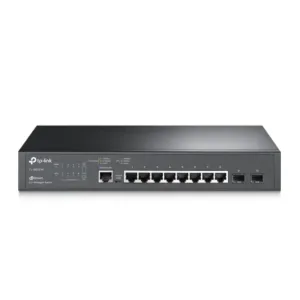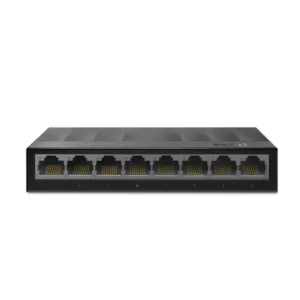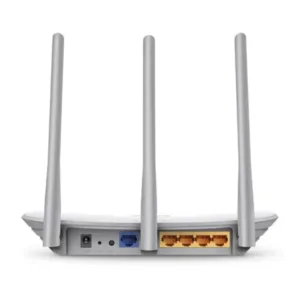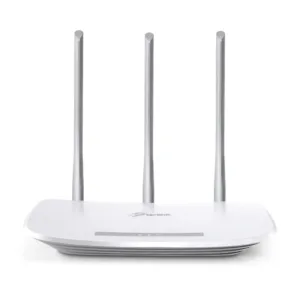Specifications
From The Manufacturer
TP-Link Archer AX6000 Specifications:
| Category | Specifications |
|---|---|
| WIRELESS | |
| Standards | Wi-Fi 6 |
| IEEE 802.11ax/ac/n/a 5 GHz | |
| IEEE 802.11ax/n/b/g 2.4 GHz | |
| Wi-Fi Speeds | AX6000 |
| 5 GHz: 4804 Mbps (802.11ax, HE160) | |
| 2.4 GHz: 1148 Mbps (802.11ax) | |
| Wi-Fi Range | 4 Bedroom Houses |
| 8× Fixed High-Performance Antennas | |
| Beamforming | |
| High-Power FEM | |
| 4T4R | |
| Wi-Fi Capacity | Very High |
| Dual-Band | |
| 4×4 MU-MIMO | |
| OFDMA | |
| Airtime Fairness | |
| DFS | |
| 8 Streams | |
| Working Modes | Router Mode |
| Access Point Mode | |
| HARDWARE | |
| Processor | 1.8 GHz 64 Bit Quad-Core CPU |
| Ethernet Ports | 1× 2.5 Gbps WAN Port |
| 8× Gigabit LAN Ports | |
| Static Link Aggregation (LAG) available with 2× LAN ports | |
| USB Support | 1× USB-C 3.0 Port |
| 1× USB-A 3.0 Port | |
| Supported Partition Formats: NTFS, exFAT, HFS+, FAT32 | |
| Supported Functions: Apple Time Machine, FTP Server, Media Server, Samba Server | |
| Buttons | Wi-Fi On/Off Button |
| Power On/Off Button | |
| LED On/Off Button | |
| WPS Button | |
| Reset Button | |
| Power | 12 V ⎓ 4 A |
| SECURITY | |
| Wi-Fi Encryption | WPA, WPA2, WPA3, WPA/WPA2-Enterprise (802.1x) |
| Network Security | SPI Firewall, Access Control, IP & MAC Binding, Application Layer Gateway |
| HomeCare™ Antivirus, Malicious Site Checker, Port Intrusion Prevention, Infected Device Isolation | |
| Notification and Log | |
| Guest Network | 1× 5 GHz Guest Network |
| 1× 2.4 GHz Guest Network | |
| VPN Server | OpenVPN, PPTP |
| SOFTWARE | |
| Protocols | IPv4, IPv6 |
| Service Kits | HomeCare™ |
| OneMesh™ Supported | |
| Parental Controls: HomeCare™ Parental Controls, Custom Profiles, Content Filtering, App Block, URL Filtering, Time Limit, Time Schedule (Bedtime), Log Insight | |
| WAN Types | Dynamic IP, Static IP, PPPoE, PPTP, L2TP |
| Quality of Service | QoS by Device, HomeCare™ QoS, QoS by Application |
| Cloud Service | Auto Firmware Upgrade, OTA Firmware Upgrade, TP-Link ID, DDNS |
| NAT Forwarding | Port Forwarding, Port Triggering, DMZ, UPnP |
| IPTV | IGMP Proxy, IGMP Snooping, Bridge, Tag VLAN |
| DHCP | Address Reservation, DHCP Client List, Server, DDNS |
| Management | Tether App, Webpage, Check Web Emulator |
| OTHER | |
| System Requirements | Internet Explorer 11+, Firefox 12.0+, Chrome 20.0+, Safari 4.0+, or other JavaScript-enabled browser, Cable or DSL Modem (if needed), Subscription with an internet service provider (for internet access) |
| Certifications | FCC, CE, RoHS |
| Environment | Operating Temperature: 0℃~40℃ (32℉ ~104℉)
Storage Temperature: -40℃~70℃ (-40℉ ~158℉) Operating Humidity: 10%~90% non-condensing Storage Humidity: 5%~90% non-condensing |
| TEST DATA | |
| Wi-Fi Transmission Power | CE: <20dBm(2.4GHz) <23dBm(5.15GHz~5.35GHz) <30dBm(5.47GHz~5.725GHz) FCC: <30dBm(2.4GHz & 5.15GHz~5.25GHz & 5.725GHz~5.825GHz) <24dBm(5.25GHz-5.35GHz & 5.47GHz-5.725 GHz) |
| Wi-Fi Reception Sensitivity | 5 GHz:
11a 6Mbps:-97dBm,11a54MBps:-79dBm 11ac VHT20 MCS0:-97dBm,11ac VHT20 MCS11:-67dBm 11ac VHT40 MCS0:-95dBm,11ac VHT40 MCS11:-64dBm 11ac VHT80 MCS0:-92dBm,11ac VHT80 MCS11:-61dBm 11ac VHT160 MCS0:-87dBm,11ac VHT160 MCS11:-55dBm 11ax HE20 MCS0:-95dBm,11ax HE20 MCS11:-64dBm 11ax HE40 MCS0:-93dBm,11ax HE40 MCS11:-61.5dBm 11ax HE80 MCS0:-89dBm,11ax HE80 MCS11:-58.5dBm 11ax HE160 MCS0:-86dBm,11ax HE160 MCS11:-56dBm 2.4 GHz: 11g 6Mbps:-97dBm,11a54MBps:-79dBm 11n HT20 MCS0:-97dBm,11n HT20 MCS7:-78dBm 11n HT40 MCS0:-95dBm,11n HT40 MCS7:-75dBm 11ac VHT20 MCS0:-96dBm,11ac VHT20 MCS11:-67dBm 11ac VHT40 MCS0:-94dBm,11ac VHT40 MCS11:-64dBm 11ax HE20 MCS0:-95dBm,11ax HE20 MCS11:-64dBm 11ax HE40 MCS0:-93dBm,11ax HE40 MCS11:-62dBm |
| PHYSICAL | |
| Dimensions (W×D×H) | 10.3 × 10.3 × 2.4 in. (261.2 × 261.2 × 60.2 mm) |
| Package Contents | Wi-Fi Router Archer AX6000, Power Adapter, RJ45 Ethernet Cable, Quick Installation Guide |

